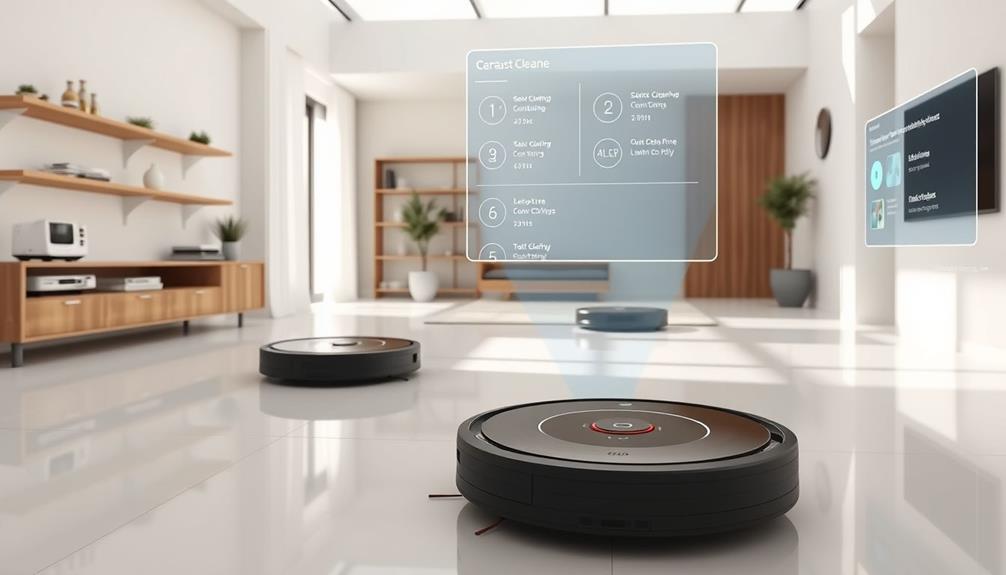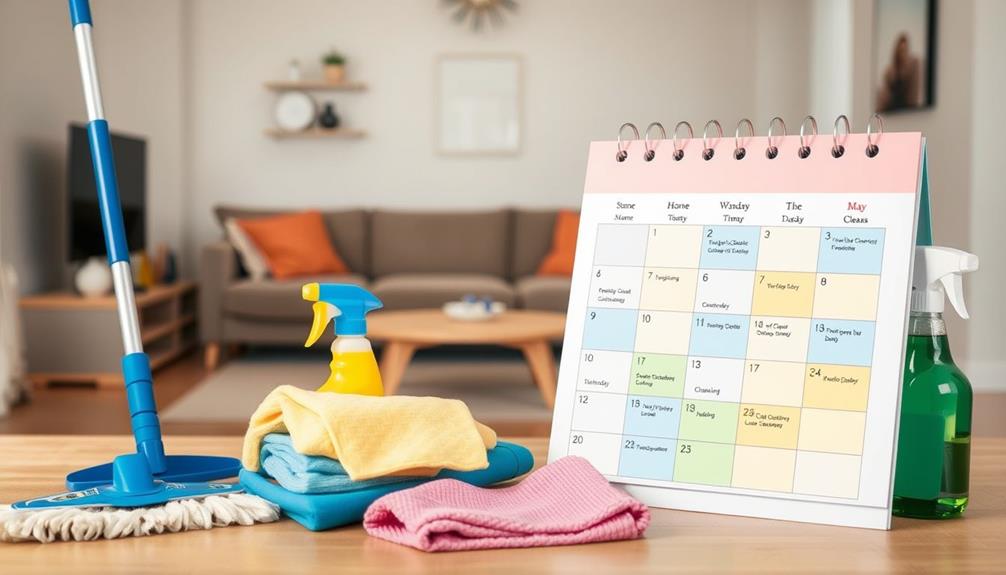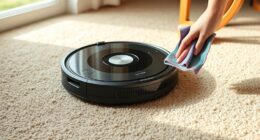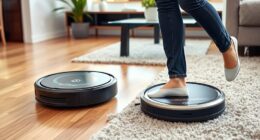Eco-friendly cleaning plays a crucial role in creating a healthier living environment and protecting the planet. One way to achieve this is by opting for environmentally friendly products, such as the Blueland Clean Essentials Kit or Dropps Laundry Pods. Utilizing reusable tools like microfiber cloths and bamboo brushes can also help reduce waste. Consider incorporating steam cleaning into your routine to avoid harmful chemicals, and make sure to regularly educate yourself on sustainable practices. When shopping for cleaning products, look for those certified by the EPA’s Safer Choice Program to ensure both safety and sustainability. By following these tips, you can enhance your cleaning regimen. Interested in exploring more eco-friendly options and detailed techniques? Discover valuable insights just ahead.
Key Takeaways
- Choose biodegradable and non-toxic products, certified by the EPA's Safer Choice Program, to minimize environmental impact and chemical exposure.
- Utilize reusable cleaning tools like microfiber cloths and bamboo brushes to reduce waste and promote sustainability in your cleaning routine.
- Opt for concentrated cleaning formulas that cut down on packaging and resource usage, making them eco-friendlier and cost-effective.
- Steam cleaning is an effective method to disinfect surfaces without the need for harsh chemicals, promoting a healthier indoor environment.
- Explore recommended eco-friendly products such as the Supernatural Starter Set and Blueland Clean Essentials Kit for effective and sustainable cleaning solutions.
Overview of Eco-Friendly Cleaning
Eco-friendly cleaning transforms your approach to maintaining a clean space while caring for the planet. By choosing eco-friendly cleaning products, you embrace a sustainable approach that prioritizes your health and the environment. These products often contain biodegradable ingredients and non-toxic substances derived from natural sources, minimizing their environmental impact. In addition to using eco-friendly cleaning products, implementing seasonal cleaning tips can further reduce your environmental impact. For example, using homemade cleaners with ingredients like vinegar and baking soda can be just as effective as store-bought products. Additionally, using reusable cleaning tools such as microfiber cloths and washable mop pads can lessen your contribution to landfill waste. Implementing these eco-friendly practices not only benefits the planet but also creates a healthier living environment for you and your loved ones.
Additionally, using air purifiers can enhance your indoor air quality by removing allergens and harmful particles, complementing your eco-friendly cleaning efforts.
Implementing green cleaning practices not only protects ecosystems but also improves your indoor air quality. Traditional cleaning products frequently release volatile organic compounds (VOCs), which can compromise your health and comfort. By opting for eco-friendly alternatives, you reduce exposure to these harmful chemicals and create a safer living environment.
Moreover, many environmentally conscious cleaning brands use recyclable packaging and promote concentrated formulas to help reduce waste. This means less plastic ending up in landfills and lower carbon emissions associated with shipping.
Regularly adopting these practices can lead to long-term cost savings, as you'll rely less on harsh chemicals and mitigate potential health-related expenses from chemical exposure.
Incorporating eco-friendly cleaning into your routine not only fosters a cleaner home but also contributes to a healthier planet. It's a win-win for you and the environment.
Recommended Eco-Friendly Products

When it comes to choosing cleaning products that are both effective and environmentally friendly, several options stand out for their innovative approaches. The Supernatural Starter Set features glass spray bottles and essential oil blends, helping you create a sustainable cleaning routine without single-use plastics, all while enjoying delightful botanical scents.
Additionally, it's important to verify that the cleaning service you choose uses eco-friendly products, which can enhance the overall safety and health of your home environment as noted in what to expect from a home cleaning service.
For convenience and reduced waste, you might consider the Blueland Clean Essentials Kit, which includes dissolvable tablet refills and reusable Tritan bottles, offering a variety of effective green cleaning products.
The Branch Basics Concentrated Cleaner Kit allows you to customize scents with enough concentrate to create multiple cleaners, encouraging minimal environmental impact as you use your own bottles.
In your laundry routine, Dropps Laundry Pods are an excellent choice; they're made from plant-based ingredients and come in compostable packaging, delivering effective cleaning without harsh chemicals.
Finally, the Seventh Generation Bathroom Cleaner is a bio-based product that disinfects without harsh chemicals, verifying a safer choice for your eco-friendly home while being packaged in environmentally friendly materials.
These recommended products can seamlessly fit into your cleaning routine while supporting a healthier planet.
Sustainable Cleaning Practices
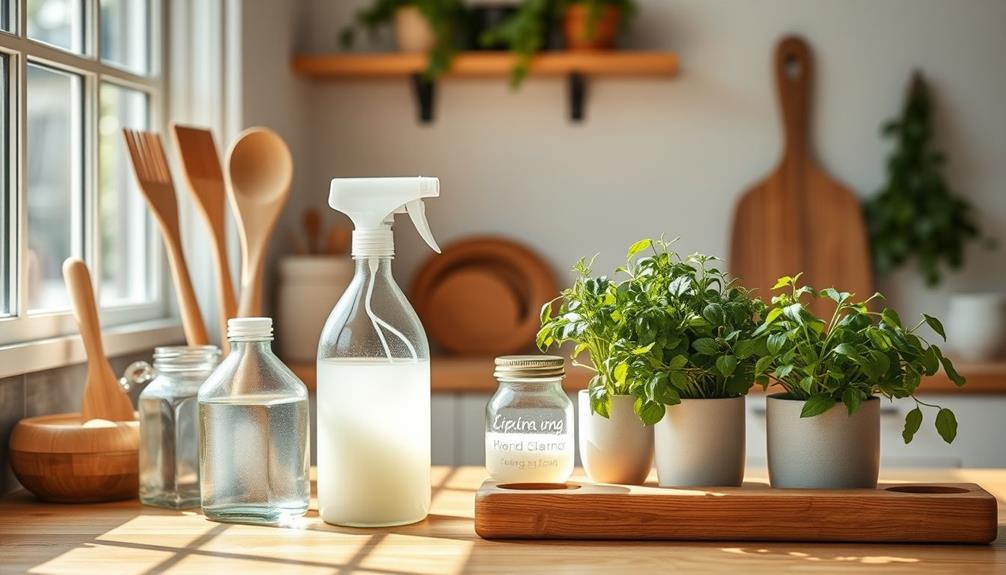
Sustainable cleaning practices can make a significant difference in both your home and the environment. By choosing biodegradable cleaning products certified by the EPA's Safer Choice Program, you reduce your environmental impact while minimizing harmful chemical exposure.
Implementing a holistic lifestyle approach, similar to those used in menopause management, can also enhance your overall well-being during your cleaning routine. You can also enhance cleaning efficiency by utilizing reusable cleaning tools like microfiber cloths and bamboo brushes, which effectively trap dirt and dust compared to disposable options.
Switching to concentrated cleaning formulas is another smart move. These products use less packaging and require fewer resources for transport, helping to minimize waste and carbon emissions.
Additionally, adopting steam cleaning methods allows you to eliminate the need for chemical disinfectants, using high-temperature steam to kill bacteria and viruses while conserving water.
Don't forget the importance of proper training for anyone involved in your cleaning routine. Regularly educating staff on eco-friendly practices guarantees they apply sustainable cleaning methods effectively, fostering a culture of environmental responsibility.
Evaluating Product Sustainability

Choosing the right cleaning products can have a lasting impact on both your health and the planet. To evaluate product sustainability effectively, keep these key factors in mind:
- Shorter ingredient lists often mean less complexity and a lower environmental footprint. For instance, using essential tips for mastering cooking techniques using butter can help you understand how to choose ingredients that are both effective and sustainable.
- Look for certifications from the EPA's Safer Choice Program to guarantee products meet health and environmental standards.
- Prioritize biodegradable products that minimize pollution and reduce exposure to harmful chemicals.
When reviewing your options, consider the recyclability of the packaging. Sustainable brands typically use minimal and renewable materials, which helps in reducing waste.
Additionally, research the brand's sustainability initiatives, such as commitments to plant-based ingredients and carbon-neutral shipping practices.
Additional Resources for Eco-Cleaning

Finding reliable resources for eco-cleaning can make a significant difference in your quest for a healthier home and planet. To help you along the way, consider utilizing resources from the Environmental Working Group (EWG) and the Environmental Protection Agency (EPA). The EWG provides a safe list that evaluates cleaning products based on their ingredients, so you can choose eco-friendly alternatives with confidence. The EPA's Safer Choice Program certifies products that meet strict health and environmental standards, ensuring you're selecting safer options.
Here's a quick reference table to guide you:
| Resource | Description | Link |
|---|---|---|
| EWG Safe List | Evaluates cleaning products for non-toxic ingredients | [EWG Safe List](https://www.ewg.org) |
| Safer Choice Program | Certifies products that meet health and environmental standards | [Safer Choice](https://www.epa.gov/saferchoice) |
| Product Reviews & Guides | Offers insights on eco-friendly alternatives and usage | [Product Reviews](https://www.goodguide.com) |
Frequently Asked Questions
What to Look for in Eco-Friendly Cleaning Products?
When you're looking for eco-friendly cleaning products, focus on those with shorter ingredient lists, as they often contain fewer harmful chemicals.
Check for certifications like the EPA Safer Choice label for reassurance. Choose biodegradable options that break down naturally and opt for concentrated formulas to cut down on packaging waste.
Ultimately, pay attention to packaging materials—select products in recyclable or compostable packaging to promote sustainability and help reduce plastic waste.
Are Eco-Friendly Cleaning Products Effective?
Yes, eco-friendly cleaning products are effective!
When you choose biodegradable ingredients and plant-based surfactants, you're opting for cleaners that tackle dirt and grime without the harsh chemicals. Many of these products perform comparably to traditional cleaners, especially when used correctly.
Just look for ones certified by the EPA's Safer Choice Program. You'll find that natural solutions like vinegar and baking soda can also tackle tough stains, proving that safety and efficiency can go hand in hand.
How Can We Make an Environmentally Friendly Cleaning Product or Solution to Clean the Classroom?
Have you ever wondered how to whip up an eco-friendly cleaning solution for your classroom?
Start by mixing equal parts distilled white vinegar and water in a spray bottle. It's simple and effective!
Want to add a pleasant scent? Just a few drops of essential oils will do.
For tough stains, sprinkle baking soda and scrub gently.
You'll be amazed at how clean and fresh your space feels—without harmful chemicals!
What Is the Definition of Eco-Friendly Cleaning Products?
Eco-friendly cleaning products are those made from natural, biodegradable ingredients that minimize harm to the environment.
They're designed to reduce toxicity in your home or workplace while improving indoor air quality.
When you choose these products, you're often opting for items that have certifications like the EPA's Safer Choice label, ensuring they meet health and environmental standards.
Plus, you'll find many come in sustainable packaging to help reduce plastic waste.
Conclusion
In the grand scheme of things, embracing eco-friendly cleaning isn't just a trend; it's a gentle shift towards a healthier planet. By choosing sustainable products and practices, you're not only sprucing up your space but also nurturing Mother Earth. So, why not take a step towards greener living? With a little effort and the right tools, you can make a world of difference—one sparkling surface at a time. Let's commence this eco-conscious journey together!

